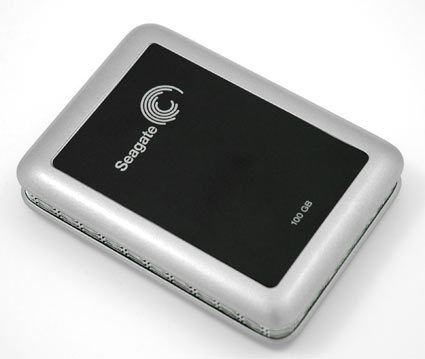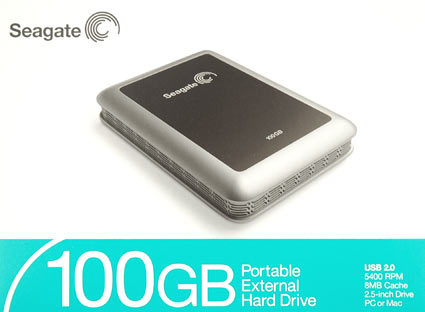Small or Smaller? Ultraportable Hard Disks
Seagate 100 GB Portable External Hard Drive
The Portable External Hard Drive is an old friend; Seagate has had it on the market for several months. The product family is built around its Momentus 5400.2 drives, which offer capacities ranging from 40, 60, 80, 100 and 120 GB. The biggest model currently available is 100 GB, with a 120 GB model planned for Q3 2005. At about the same time, the Momentus 5400.3 drives should ship, which top out at 160 GB; these will then likely also make their way into the Portable External Hard Drive lineup.
All drives in the Momentus 5400.2 family are equipped with 8 MB of cache; as the name indicates, they also rotate at a speedy 5400 RPM. Until now, ATA/100 has been the only controller interface available for this kind of drive, but SATA versions should be available soon. Fujitsu, Hitachi, and Samsung SATA drives tend to be faster than Seagate's offerings, but for external USB 2.0 drives, this really doesn't matter much.
Looking at a data transfer diagram, it's easy to recognize that the USB bus imposes a bottleneck on the Momentus drives currently available. With somewhere in the neighborhood of 28 MB/s of read throughput, performance lags behind theoretical maximum, which could technically reach levels of up to 35 MB/s.
The Seagate Portable External Hard Drive weighs only 10.3 oz (292 g) and ships with a special USB cable that requires two USB ports on its computer end. The second port is needed to deliver sufficient DC power to run the drive; it wouldn't work using only a single USB port on our test system. This experience indicates clearly that USB power levels can't meet all needs, particularly when a power-hungry device like a 5400 RPM hard disk is brought into play.
One undeniable shortcoming of the Seagate Portable External Hard drive is the manufacturer's 1 year warranty, which is too short. This is a significant issue, especially in Europe, where legal requirements require that end-users get a two-year warranty. This obligates dealers and systems integrators to assume part of the support and replacement costs, which they may then pass on to consumers.
Get Tom's Hardware's best news and in-depth reviews, straight to your inbox.
Current page: Seagate 100 GB Portable External Hard Drive
Prev Page 1.8" Or 2.5" Ultraportable Drives From Seagate And Transcend Next Page Transcend StoreJet 20 GB
Patrick Schmid was the editor-in-chief for Tom's Hardware from 2005 to 2006. He wrote numerous articles on a wide range of hardware topics, including storage, CPUs, and system builds.



